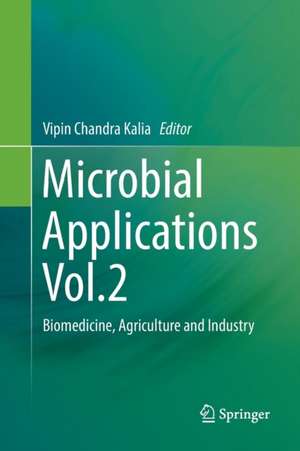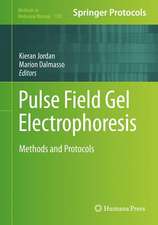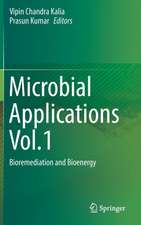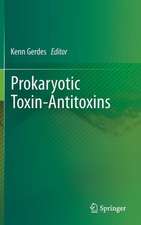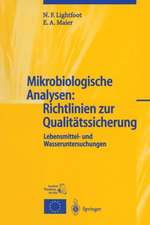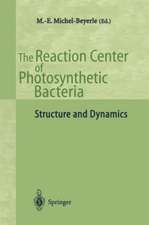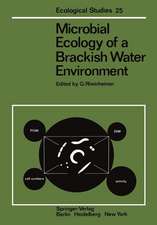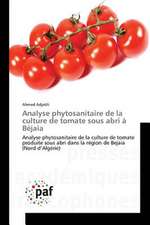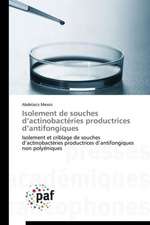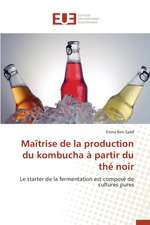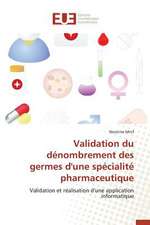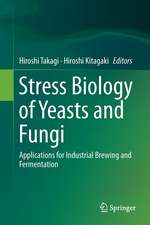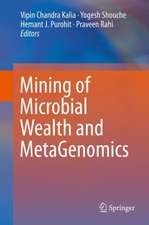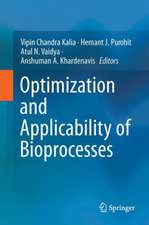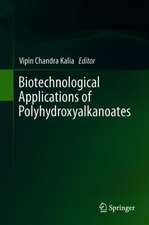Microbial Applications Vol.2: Biomedicine, Agriculture and Industry
Editat de Vipin Chandra Kaliaen Limba Engleză Paperback – 18 iul 2018
| Toate formatele și edițiile | Preț | Express |
|---|---|---|
| Paperback (1) | 947.04 lei 6-8 săpt. | |
| Springer International Publishing – 18 iul 2018 | 947.04 lei 6-8 săpt. | |
| Hardback (1) | 953.20 lei 6-8 săpt. | |
| Springer International Publishing – 25 apr 2017 | 953.20 lei 6-8 săpt. |
Preț: 947.04 lei
Preț vechi: 1154.93 lei
-18% Nou
Puncte Express: 1421
Preț estimativ în valută:
181.21€ • 189.71$ • 149.94£
181.21€ • 189.71$ • 149.94£
Carte tipărită la comandă
Livrare economică 05-19 aprilie
Preluare comenzi: 021 569.72.76
Specificații
ISBN-13: 9783319849584
ISBN-10: 3319849581
Ilustrații: XI, 336 p. 70 illus., 24 illus. in color.
Dimensiuni: 155 x 235 mm
Greutate: 0.49 kg
Ediția:Softcover reprint of the original 1st ed. 2017
Editura: Springer International Publishing
Colecția Springer
Locul publicării:Cham, Switzerland
ISBN-10: 3319849581
Ilustrații: XI, 336 p. 70 illus., 24 illus. in color.
Dimensiuni: 155 x 235 mm
Greutate: 0.49 kg
Ediția:Softcover reprint of the original 1st ed. 2017
Editura: Springer International Publishing
Colecția Springer
Locul publicării:Cham, Switzerland
Cuprins
part I. Biomedicine.- 1. Role of Bacteria in Nanocompounds formation and their Application in Medical.- 2. Microbial Source of Melatonin and Its Clinical Aspects.- 3. Major Source of Marine Actinobacteria and its Biomedical application.- 4. Antimycobacterial Agents: To Target or Not to Target.- Part II. Agriculture.- 5. Microbial Biofilm: Role in crop productivity.- 6. Bacterial quorum sensing (QS) in rhizosphere (paddy soil): Understanding soil signaling and N- recycling for increased crop production.- 7. Use of Plant Growth Promoting Rhizobacteria as biocontrol agents. Induced systemic resistance against biotic stress in plants.- 8. Biological Routes for the Synthesis of Platform Chemicals from Biomass Feedstocks.- Part III. Industry.- 9. Green synthesis of hydroxamic acid and its potential industrial applications.- 10. Bioactive Natural Products: An overview- with particular emphasis on those possessingpotential to inhibit microbial quorum sensing.- 11. Fungi imperfecti laccase: Biotechnological potential and perspectives.- 12. Biosurfactants: a multifunctional microbial metabolite.- 13. Bioproduction of polyhydroxyalkanoate from plant oils.- 14. Microbial Synthesis of Polyhydroxyalkanoates: Diversification.- 15. Microbe derived itaconic acid: Novel route for biopolyamides.- 16. Basics of Methanogenesis in Anaerobic Digester.- 17. Laccases: Blue Copper Oxidase in Lignocellulose Processing.
Notă biografică
Dr. Vipin Chandra Kalia is presently working as Chief Scientist at Microbial Biotechnology and Genomics, CSIR-Institute of Genomics and Integrative Biology, Delhi. He is a Professor of Academy of Scientific and Innovative Research (AcSIR), Delhi. He obtained his M.Sc. and Ph.D. degrees in Genetics from the Indian Agricultural Research Institute, New Delhi. He has been elected as: (1) Fellow of the Association of Microbiologists of India (FAMI), (2) Fellow of the National Academy of Sciences (FNASc), and (3) Fellow of National Academy of agricultural Sciences (FNAAS). His main areas of research are microbial biodiversity, genomics, and evolution, bioenergy, biopolymers, antimicrobials, quorum sensing, and quorum quenching. He has published 101 papers in scientific journals such as (1) Nature Biotechnology, (2) Biotechnology Advances, (3) Trends in Biotechnology, (4) Critical Reviews in Microbiology, (5) Bioresource Technology, (6) International Journal of Hydrogen Energy, (7) PLoS ONE, (8) BMC Genomics, (9) Gene, and (10) Annual Review of Microbiology. His works have been cited 3558 times with a h index of 31 and an i10 index of 66. He has edited 3 books: Quorum sensing versus quorum quenching: A battle with no end in sight (2015, Springer India), Microbial Factories Vol 1 and 2 (2015). He is presently the editor in chief of the Indian Journal of Microbiology and Editor of (1) PLoS ONE, (2)Journal of Microbiology & Biotechnology (Korea), (3) Applied Biochemistry & Biotechnology (USA), (4) International Scholarly Research Notices (Energy), (5) Dataset Papers in Science (Microbiology), and (6) Journal of Molecular and Genetic Medicine. He is a life member of the following scientific societies: (1) Society of Biological Chemists of India (2) Society for Plant Biochemistry and Biotechnology, India; (3) Association of Microbiologists of India; (4) Indian Science Congress Association; (5) BioEnergy Society of India, and (6) the Biotech Research Society ofIndia (BRSI). He is also a member of the American Society for Microbiology.
Textul de pe ultima copertă
This contributed volume provides insights into multiple applications using microbes to promote productivity in agriculture, to produce biochemicals or to respond to challenges in biomedicine. It highlights the microbial production of nanocompounds with medical functionality alongside new anti-mycobacterial strategies, and introduces plant-growth-promoting Rhizobacteria as well as the correlation between biofilm formation and crop productivity. Further, the authors illustrate the green synthesis of biochemical compounds, such as hydroxamid acid or biosurfactants, using microbial and fungal enzymes. It inspires young researchers and experienced scientists in the field of microbiology to explore the combined use of green, white and red biotechnology for industrial purposes, which will be one of the central topics for future generations.
Caracteristici
Broadens understanding of current microbial applications Contains practical examples on industrial opportunities Illustrates crop productivity improvement using microbes
